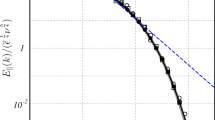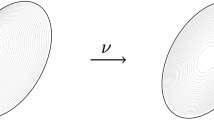Abstract
Different local features at the surface of a body are breaks or sharp changes in boundary conditions, separation or joining of a flow, irregularities, etc., and they may have a marked effect on local and global characteristics of flow over it [1]. This situation stimulates continued interest towards to flow in local regions, which apart from considerable practical importance, often exhibit considerable theoretical novelty (see, e.g., [2–6], where a systematic study was carried out of planar local regions of flow). However, the majority of local regions are spatial, and whereas in studying flat regions considerable success have been achieved, for spatial regions only individual solutions have been obtained, often using considerable simplifications [7–19]. In addition, due to the absence of systematic studies it is difficult to determine the boundaries for existence of different flow regimes in local spatial regions, and limiting transitions which make it possible to changeover from one flow regime to another. In this work systematic studies are carried out for flow regimes in local spatial regions for each of the boundary problems formulated, the main properties of their solution are studied, and a general classification for the arrangement of flow regimes is built up.
Similar content being viewed by others
Literature cited
R. Sedney, “A survey of the effects of small protuberances on boundary layer flows,” AIAA J.,11, No. 6 (1973).
B. Ya. Neiland “Asymptotic problems for the theory of viscous supersonic flows,” Tr. TsAGI, No. 1529 (1974).
V. V. Bogolepov and V. Ya. Neiland, “Study of local disturbances for viscous supersonic flows,” in: Aeromechanics [in Russian], Nauka, Moscow (1976).
A. I. Ruban and V. V. Sychev, “Asymptotic theory for separation of a laminar boundary layer in an incompressible liquid,” Usp. Mekh.,2, No. 4 (1979).
I. I. Lipatov, “Thermal protection of a section of finite length with intense local blowing,” Tr. TsAGI, No. 2080 (1980).
V. Ya. Neiland, “Asymptotic theory of separation and reaction of a boundary layer with a supersonic gas stream,” Usp. Mekh.,4, No. 2 (1981).
O. V. Denisenko, “Flow over longitudinal grooves by a stream of viscous gas,” Uchen. Zap. TsAGI,9, No. 4 (1978).
I. I. Lipatov, “Spatial flow over a small irregularity by a laminar boundary layer,” Uchen. Zap. TsAGI,11, No. 2 (1980).
F. T. Smith, R. I. Sykes, and P. W. M. Brighton, “A two-dimensional boundary layer encountering a three-dimensional hump,” J. Fluid Mech.,83, 1 (1977).
R. I. Sykes, “Stratification effects in boundary flow over hills,” Proc. R. Soc. London,A361, N 1705 (1978).
I. I. Lipatov, “Flow over local spatial irregularities at the bottom of a laminar boundary layer in a free hypersonic reaction regime,” Tr. TsAGI, No. 2079 (1980).
P. J. Mason and R. I. Sykes, “Three-dimensional numerical integrations of the Navier -Stokes equations for flow over surface mounted obstacles,” J. Fluid. Mech.,91, 3 (1979).
O. S. Ryzhov, “A nonstationary spatial boundary layer freely reacting with an external stream,” Prikl. Mat. Mekh.,44, No. 6 (1980).
V. I. Zhuk and O. S. Ryzhov, “Stability of a freely reacting boundary layer,” Prikl. Mat. Mekh.,45, No. 3 (1981).
S. V. Manuilovich, “A freely-reacting spatial boundary layer with an external potential flow,” Izv. Akad. Nauk SSSR, Mekh. Zhidk. Gaza, No. 5 (1983).
F. T. Smith, “A three-dimensional boundary layer separation,” J. Fluid Mech.,99, No. 1 (1980).
R. I. Sykes, “On three-dimensional boundary layer flow over surface irregularities,” Proc. R. Soc. London,A373, N 1754 (1980).
A. V. Kazakov, “Reaction of a nonsteady spatial boundary layer with a hypersonic stream around a rapidly-heated section of a surface,” Izv. Akad. Nauk SSSR, Mekh. Zhidk. Gaza, No. 5 (1983).
V. V. Bogolepov and I. I. Lipatov, “Study of spatial local laminar flows,” Zh. Prikl. Mekh. Tekh. Fiz., No. 1 (1985).
V. V. Bogolepov, “Flow over a semicylindrical hump in the surface of a plate by a shear stream of viscous liquid,” Izv. Akad. Nauk SSSR, Mekh. Zhidk. Gaza, No. 6 (1975).
V. V. Bogolepov, “Calculation of the reaction of a supersonic boundary layer with a thin barrier,” Uchen. Zap. TsAGI,5, No. 6 (1974).
V. V. Bogolepov, “Study of limiting solutions for the case of flow over small irregularities in the surface of a body by a supersonic stream of viscous gas,” Tr. TsAGI, No. 1812 (1977).
Author information
Authors and Affiliations
Additional information
Translated from Zhurnal Prikladnoi Mekhaniki i Tekhnicheskoi Fiziki, No. 6, pp. 80–91, November–December, 1986.
Rights and permissions
About this article
Cite this article
Bogolepov, V.V. General arrangement of regimes for spatial local flows. J Appl Mech Tech Phys 27, 860–869 (1986). https://doi.org/10.1007/BF00918829
Received:
Issue Date:
DOI: https://doi.org/10.1007/BF00918829




